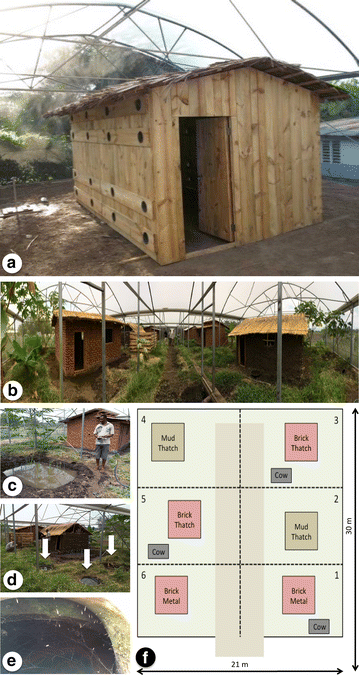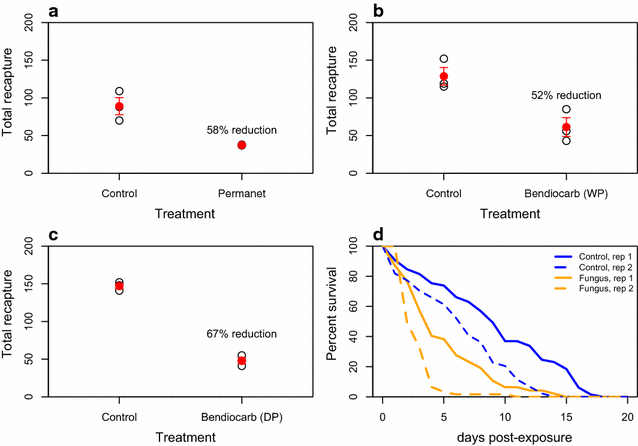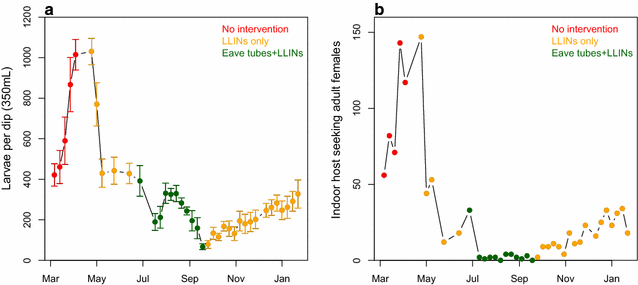Eave tubes for malaria control in Africa: initial development and semi-field evaluations in Tanzania
- PMID: 27586055
- PMCID: PMC5009540
- DOI: 10.1186/s12936-016-1499-8
Eave tubes for malaria control in Africa: initial development and semi-field evaluations in Tanzania
Abstract
Background: Presented here are a series of preliminary experiments evaluating "eave tubes"-a technology that combines house screening with a novel method of delivering insecticides for control of malaria mosquitoes.
Methods: Eave tubes were first evaluated with overnight release and recapture of mosquitoes in a screened compartment containing a hut and human sleeper. Recapture numbers were used as a proxy for overnight survival. These trials tested physical characteristics of the eave tubes (height, diameter, angle), and different active ingredients (bendiocarb, LLIN material, fungus). Eave tubes in a hut with closed eaves were also compared to an LLIN protecting a sleeper in a hut with open eaves. Eave tubes were then evaluated in a larger compartment containing a self-replicating mosquito population, vegetation, and multiple houses and cattle sheds. In this "model village", LLINs were introduced first, followed by eave tubes and associated house modifications.
Results: Initial testing suggested that tubes placed horizontally and at eave height had the biggest impact on mosquito recapture relative to respective controls. Comparison of active ingredients suggested roughly equivalent effects from bendiocarb, LLIN material, and fungal spores (although speed of kill was slower for fungus). The impact of treated netting on recapture rates ranged from 50 to 70 % reduction relative to controls. In subsequent experiments comparing bendiocarb-treated netting in eave tubes against a standard LLIN, the effect size was smaller but the eave tubes with closed eaves performed at least as well as the LLIN with open eaves. In the model village, introducing LLINs led to an approximate 60 % reduction in larval densities and 85 % reduction in indoor catches of host-seeking mosquitoes relative to pre-intervention values. Installing eave tubes and screening further reduced larval density (93 % relative to pre intervention values) and virtually eliminated indoor host-seeking mosquitoes. When the eave tubes and screening were removed, larval and adult catches recovered to pre-eave tube levels.
Conclusions: These trials suggest that the "eave tube" package can impact overnight survival of host-seeking mosquitoes and can suppress mosquito populations, even in a complex environment. Further testing is now required to evaluate the robustness of these findings and demonstrate impact under field conditions.
Keywords: Beauveria bassiana; Eave tubes; House improvement; Semi-field system.
Figures





References
-
- WHO. Global plan for insecticide resistance management in malaria vectors. Geneva: World Health Organization. http://www.who.int/malaria/publications/atoz/gpirm/en/. Accessed 9 Nov 2015.
-
- Lengeler C. Insecticide-treated bed nets and curtains for preventing malaria. Cochrane Database Syst. Rev. 2004;2:CD000363. - PubMed
Publication types
MeSH terms
LinkOut - more resources
Full Text Sources
Other Literature Sources
Medical

